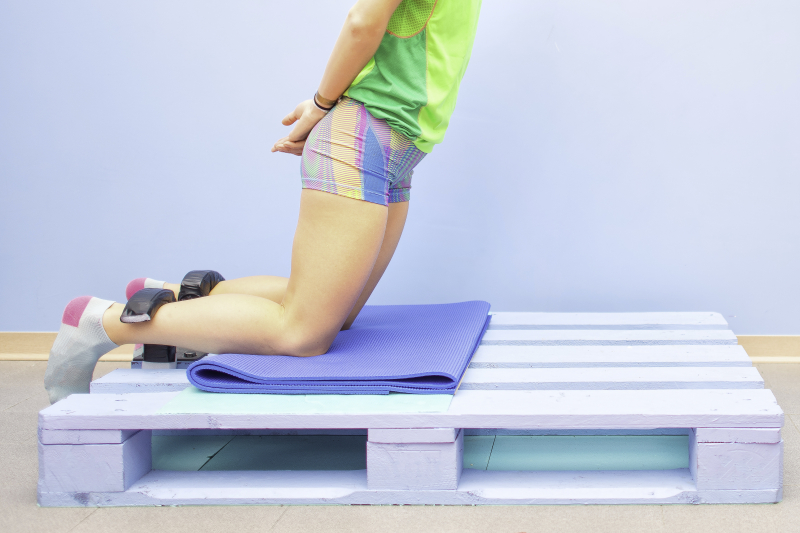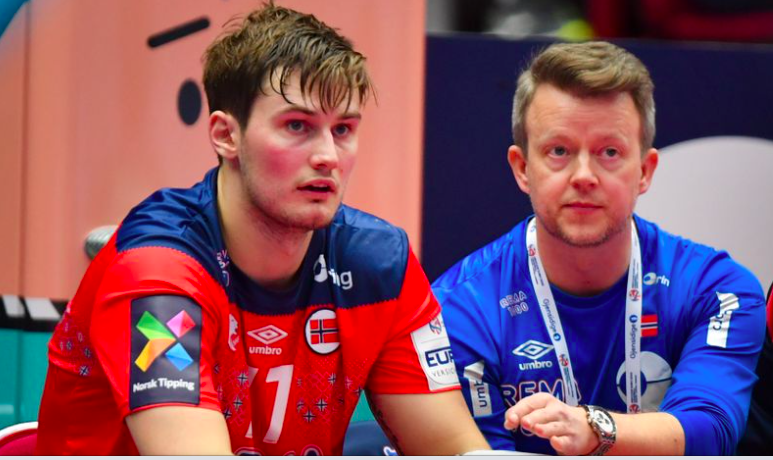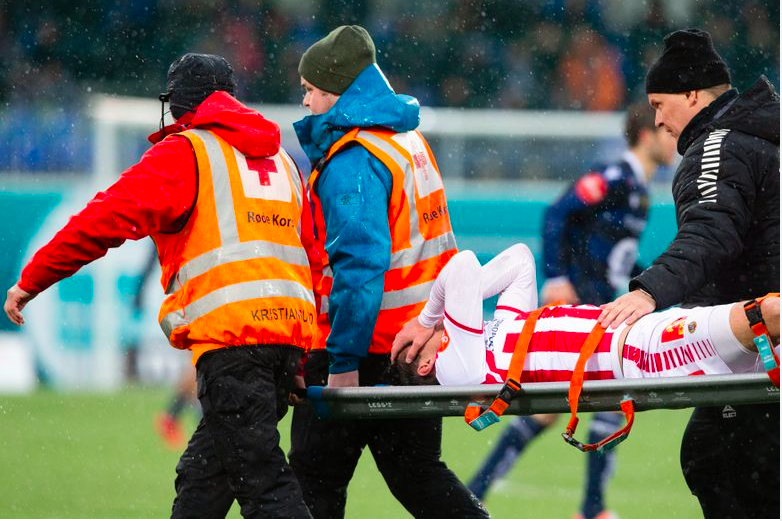Foto: Svein Ove Ekornesvåg/NTB Scanpix
On the 2.nd of November 2019, my local newspaper published an article highlighting our local football team. The headline was “An injury nightmare for Tromsø football club.” (football = soccer)
According to the article, 23 players had sustained an injury during the previous year. Some players suffered from multiple an repeated injuries and some were of a more serious nature. The article focused on the number of players injured, the type of injuries, and questioned whether the team`s injury burden was heavier than expected.
The former head coach of the team, Simo Valakari, offered a short statement in the article: “Injuries happen. They are part of football.” He then passed the subject and journalist on to the team physician Jorid Degerstrøm for further comments. It is possible to interpret his statement like this: 1) Injuries are hard to avoid 2) It is the medical team`s responsibility to prevent and follow-up on injuries. Valakari`s comment is nothing out of the ordinary. Rather it is a typical example of how coaches respond to questions regarding player injuries. In this post, I will take a closer look at “Are injuries in fact hard to avoid?” and “Who is responsible for football injuries?” But first, I will address possible relationships between injuries and performance.
Relationships between injuries and performance
Coaches, assisted by media and their angling of questions, often utilize injuries directly or indirectly to justify bad performance. This may be expressed as: “Five of our key players were unavailable today”. “We`ve been extremely unfortunate with injuries:” “We have to play the players available.” “Currently, the squad is really stretched.” “We would love to have Runar available.”
It is easy to view injuries and performance in conjunction with each other. Common sense allows this. Furthermore, it is well documented that there is a relationship between player health and availability for performance. A study published in 2013 followed 24 football teams from 9 countries during 11 seasons. The aim of the study was to explore connections between injury burden and team performance, in both national leagues and in the European cups. The study indicated that a low number of injuries and a high degree of player availability is associated with more points pr. game, and higher performance in the European cup. Thus: Injury burden seems to impact measurably on team performance.
In football, the risk of injury is higher during matches compared to training, and higher towards the end of each half. On average, professional players in major leagues miss 37 days a year due to injuries. This number may be even higher for players from teams who have limited access to heath resources. In other words: A team may expect an annual loss of at least 12% of estimated player resources due to injuries.
Injuries happen – or?
Of course, Simo Valakari was partly right. Some injuries are going to happen, no matter what. But not all. Injury prevention exercises may reduce injury risk in football significantly. Some illustrations taken from recent meta-analyses and reviews:

The risk of overuse injuries increases with a mismatch between load and recovery. Poor load management is associated with increased risk of injury. Rapid increases of load appear to represent a notable risk factor for injuries. Players come with different baselines and different fitness-levels. They have diverse responses to exercise and to recovery, and they have various life strains and commitments outside of the football arena. Individualized adjustment of load is of great importance, also in team sports.
Furthermore, previous injuries increase the risk of new injuries. If you have had one ankle sprain, you are more prone to a future ankle sprain. The same applies to several other common football injuries; muscle strains, kne injuries and groin pain. Return to play from reinjury usually requires more time than return to play from the initial injury. This implies that preventive measures targeted to avoid the initial injury is especially important. If an injury does occur, a gradual exposure to training and matches is essential.
Injuries are related to performance level, and a good portion of injuries are preventable. Why then are injuries still hard to prevent? Why does club management accept 12% loss of player resources? Not to mention the human costs. To go through injury and rehabilitation is mentally hard on the player.
Injuries are the medica team`s responsibility – or?
It is accurate to say that members of the medical team hold main responsibility of medical issues (usually physiotherapist and team physician). However, injury prevention and injury treatment are complicated and not simply a question of either-or: Overuse injuries develop over time, and acute injuries occur more often if there is a preceeding injury. Moreover, following an injury, progressive increase of load is crucial. This implies that injury prevention and injury management demand close collaboration of the coach, player and physio/team physician. Such integration and teamwork may differ in terms of form and quality.
A study from Ekstrand et al highlights the association between the head coach`s communication with the medical team and the number of injuries. The incidence of serious injuries is higher in teams where the quality of communication is low. Cooperation and high quality of communication seem to be an important measure for injury prevention.
Another study from Ekstrand et al points to the fact that the incidence of serious injuries is lower in teams where the head coach performs transformative leadership. Transformative leaders involve, motivate and inspire others to reach beyond self-interest for the benefit of the collective best. This leadership style is characterized by clear visions, a democratic and involving attitude, focus on creating meaningful situations, and highlights the values of challenge and stimulation. (The comparative leadership styles are transactional leadership and laisses-faire leadership). Players attendance is higher when the manager`s leadership style is encouraging and approving. It is important that the coach encourages innovative thinking and emphasizes trust and cooperation. The coach should present as a good and positive role model.

In summary, the studies by Ekstand et al indicate that there are clear links connecting injury incidence, player availability and coach leadership styles.
NB: It is easy to be captivated by a charismatic leadership style. A charismatic coach is often perceived as an efficient leader, and per se important for team performance. Ekstrand et al show no correlations between a charismatic leadership style and injury burden/player availability.
Common process
Injuries are costly. They cost money and points, and they have personal costs, not so easily measured and acknowledged. It is about time the football communities recognize that it is possible to reduce injury burden significantly. Understanding injury prevention, and injury prevention strategies should be an essential part of education plans for coaches of all levels.
Clubs should understand and accept responsibility for injury prevention and include player health as part of the clubs performance and economic objectives, thus hiring coaches who are knowledgeable about injury prevention strategies and possess corresponding and suitable leadership and communication skills. Additionally, clubs should seek and hire physiotherapists who participate, and execute their preventive initiatives and follow-ups on field. This mode of service facilitates cooperation between players, coach and physio.

Team handball has perhaps already taken the message to heart. National team coach Christian Berge says the following about physiotherapist and manual therapist Harald Markussen: “He is extremely important. We require fit and healthy players. That`s our first priority.”
Foto: Bjørn S. Delebekk
Markussen says: “ It is extremely rewarding as a health professional to be allowed to do preventive work, instead of putting out fires. Team handball was traditionally a “firefighting sport” with no focus on injury prevention strategies. But at the present, the National Handball Federation of Norway has become a pioneer federation. As far as I know, no one prioritises health issues on the same level as they do.”
We can only hope that sound attitudes towards health and injury prevention are adopted by football; by clubs, and teams of all levels. Everybody benefits from healthy and available players. This is possible to achieve considerably better than today, if everybody involved is made aware of, and accept their responsibilities.
References
Al Attar, W. S. A., Soomro, N., Sinclair, P. J., Pappas, E., & Sanders, R. H. (2017). Effect of Injury Prevention Programs that Include the Nordic Hamstring Exercise on Hamstring Injury Rates in Soccer Players: A Systematic Review and Meta-Analysis. Sports Medicine, 47(5), 907-916. doi:10.1007/s40279-016-0638-2
Ekstrand, J., Hägglund, M., & Waldén, M. (2011). Injury incidence and injury patterns in professional football: the UEFA injury study. Br J Sports Med, 45(7), 553-558. doi:10.1136/bjsm.2009.060582
Ekstrand, J., Lundqvist, D., Davison, M., D’Hooghe, M., & Pensgaard, A. M. (2019). Communication quality between the medical team and the head coach/manager is associated with injury burden and player availability in elite football clubs. Br J Sports Med, 53(5), 304-308. doi:10.1136/bjsports-2018-099411
Ekstrand, J., Lundqvist, D., Lagerbäck, L., Vouillamoz, M., Papadimitiou, N., & Karlsson, J. (2018). Is there a correlation between coaches’ leadership styles and injuries in elite football teams? A study of 36 elite teams in 17 countries. Br J Sports Med, 52(8), 527-531. doi:10.1136/bjsports-2017-098001
Harøy, J., Clarsen, B., Wiger, E. G., Øyen, M. G., Serner, A., Thorborg, K., . . . Bahr, R. (2018). 20 The preventive effect of an adductor strengthening programme on groin problems among male football players: a cluster-randomised controlled trial. Br J Sports Med, 52(Suppl 1), A7-A8. doi:10.1136/bjsports-2018-099334.20
Huang, Y.-L., Jung, J., Mulligan, C. M. S., Oh, J., & Norcross, M. F. (2020). A Majority of Anterior Cruciate Ligament Injuries Can Be Prevented by Injury Prevention Programs: A Systematic Review of Randomized Controlled Trials and Cluster–Randomized Controlled Trials With Meta-analysis. The American Journal of Sports Medicine, 48(6), 1505-1515. doi:10.1177/0363546519870175
Hägglund, M., Waldén, M., Magnusson, H., Kristenson, K., Bengtsson, H., & Ekstrand, J. (2013). Injuries affect team performance negatively in professional football: an 11-year follow-up of the UEFA Champions League injury study. Br J Sports Med, 47(12), 738-742. doi:10.1136/bjsports-2013-092215
Malone, S., Owen, A., Newton, M., Mendes, B., Collins, K. D., & Gabbett, T. J. (2017). The acute:chonic workload ratio in relation to injury risk in professional soccer. Journal of Science and Medicine in Sport, 20(6), 561-565. doi:https://doi.org/10.1016/j.jsams.2016.10.014
Nessler, T., Denney, L., & Sampley, J. (2017). ACL Injury Prevention: What Does Research Tell Us? Current Reviews in Musculoskeletal Medicine, 10(3), 281-288. doi:10.1007/s12178-017-9416-5
Owoeye, O., Palacios-Derflingher, L., & Emery, C. (2017). Risk factors for ankle sprain injury in youth soccer and basketball. Br J Sports Med, 51(Suppl 1), A4-A4. doi:10.1136/bjsports-2017-anklesymp.10
Soligard, T., Schwellnus, M., Alonso, J.-M., Bahr, R., Clarsen, B., Dijkstra, H. P., . . . Engebretsen, L. (2016). How much is too much? (Part 1) International Olympic Committee consensus statement on load in sport and risk of injury. Br J Sports Med, 50(17), 1030-1041. doi:10.1136/bjsports-2016-096581
